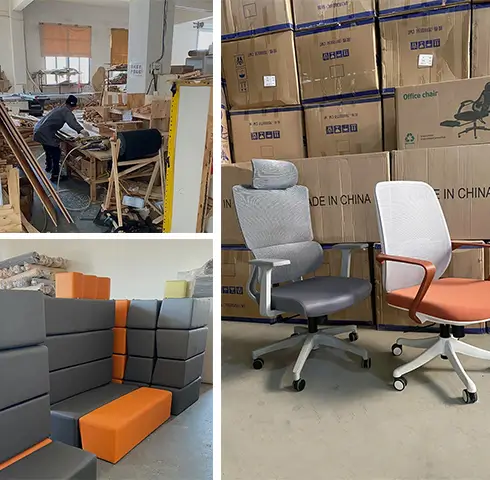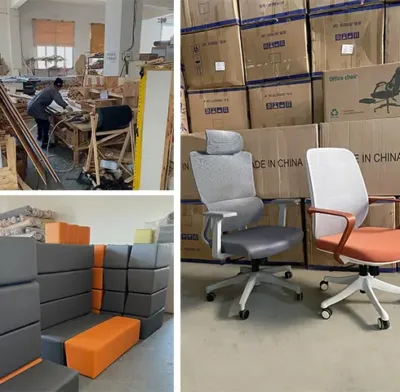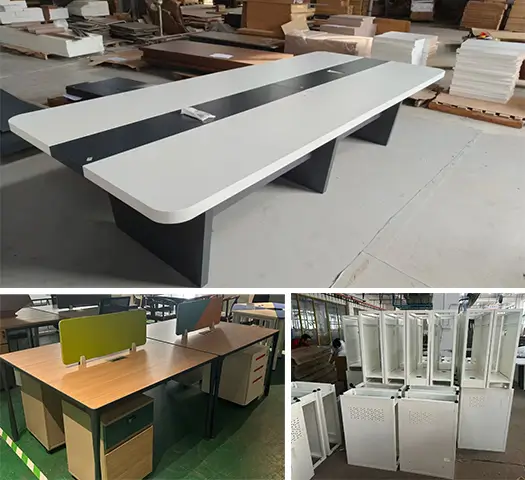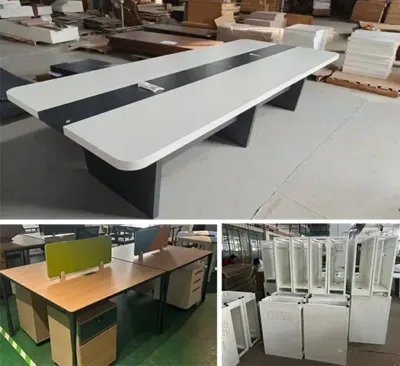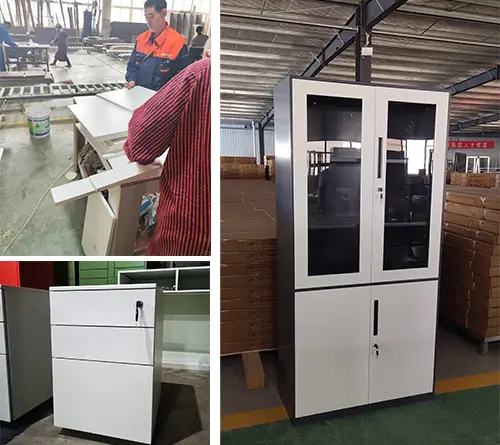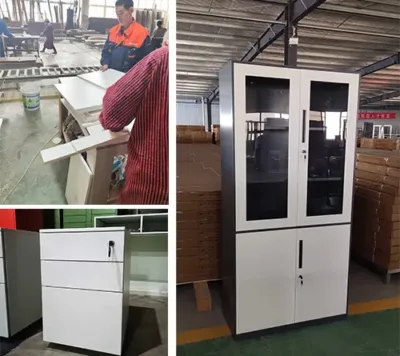Factory-Direct Office Furniture Supplier
- 10+ years in office furniture sourcing.
- Flexible MOQs with consistent quality.
- Tailored solutions for office fit-out projects.
- Consolidated sourcing across office furniture.
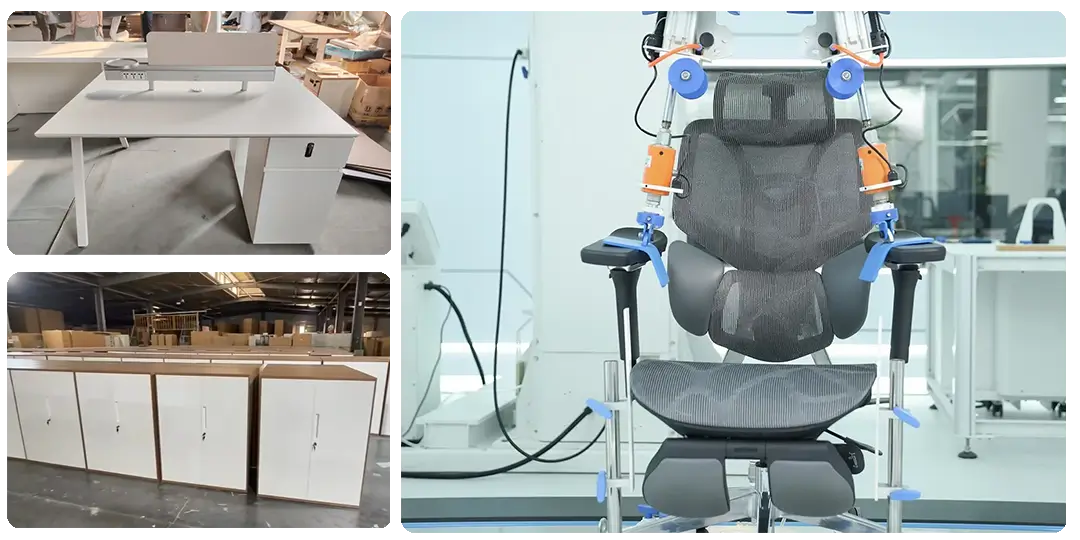
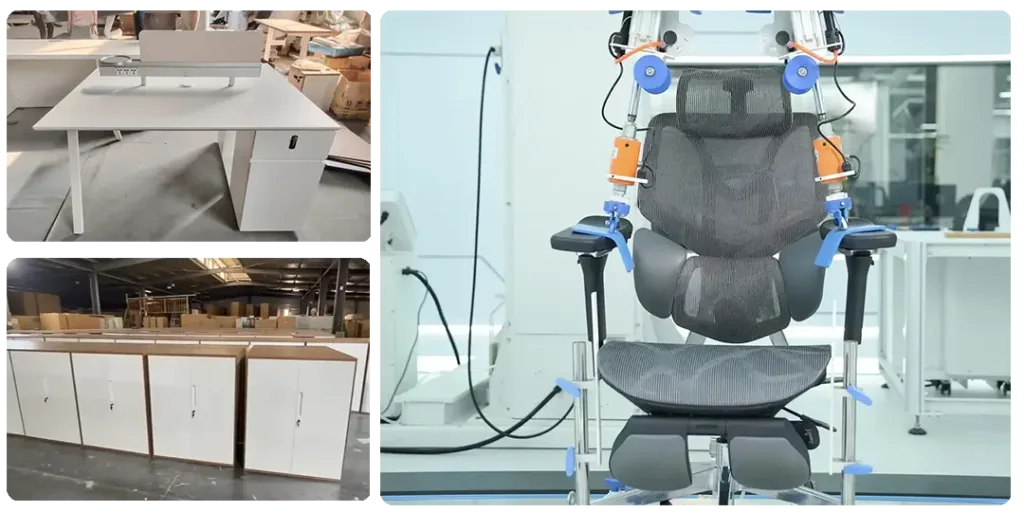
Most sourced types of office furniture
Office chairs & seating
We provide cost-effective office chairs and seating solutions tailored to your budget & configuration needs.
- Task & meeting chairs: basic fixed models usually under $10/pc; swivel, height-adjustable models around $15/pc.
- Executive chairs: $20–70/pc, depending on comfort (structure + seat cushioning) and stability (base materials, gas lift grade).
- Office sofas: designed for durability and flexible layouts rather than home-style comfort. PU leather single + 3-seat sets for reception areas start at around $300/set.
We support custom logos on products and packaging, and also handle seating sourcing for office-related commercial spaces like clubs and coworking spaces.
Office chairs & seating
We provide cost-effective office chairs and seating solutions tailored to your budget & configuration needs.
- Task & meeting chairs: basic fixed models usually under $10/pc; swivel, height-adjustable models around $15/pc.
- Executive chairs: $20–70/pc, depending on comfort (structure + seat cushioning) and stability (base materials, gas lift grade).
- Office sofas: designed for durability & flexible layouts rather than home-style comfort. PU leather single + 3-seat sets for reception areas start at $300/set.
We support custom logos on products and packaging, and also handle seating sourcing for office-related commercial spaces like clubs and coworking spaces.
Office desks & tables
Desk and table sourcing mainly depends on workspace layout, dimensions, and budget. Standard desks for employees, meeting and reception areas are usually made of MDF or particle board.
- 3.6 m face-to-face 6-person workstation desks: typically under $200/pc.
- 1.6 m meeting tables: around $100/pc.
It’s common and easy to customize desktop finishes, including melamine lamination, spray coating, wood veneer, etc.
Additionally, we handle some government and school projects that require custom designs beyond standard specifications.
Office desks & tables
Desk and table sourcing mainly depends on workspace layout, dimensions, and budget.
Standard desks for employees, meeting and reception areas are usually made of MDF or particle board.
- 3.6 m face-to-face 6-person workstation desks: typically under $200/pc.
- 1.6 m meeting tables: around $100/pc.
It’s common and easy to customize desktop finishes, including melamine lamination, spray coating, wood veneer, etc.
Additionally, we handle some government and school projects that require custom designs beyond standard specifications.
Officce storage furniture
Mobile cabinets are the most commonly purchased type, typically used alongside workstations.
- A typical 1-drawer + 1-door mobile pedestal is around $15.
- Prices increase as more drawers are added.
Another commonly sourced type is fixed cabinets, usually lockable, with doors and shelves.
- Wooden filing cabinets: 1850 × 900 × 400 mm, around $100 for a 12-door design, and $90 for a double-door version.
- Steel filing cabinets: with similar dimensions, double-door design, around $70 per unit.
Officce storage furniture
Mobile cabinets are the most commonly purchased type, typically used alongside workstations.
- A typical 1-drawer + 1-door mobile pedestal is around $15.
- Prices increase as more drawers are added.
Another common type is fixed cabinets, usually lockable, with doors and shelves.
- Wooden filing cabinets: 1850 × 900 × 400 mm, around $100 for a 12-door design, and $90 for a double-door version.
- Steel filing cabinets: with similar dimensions, double-door design, around $70 per unit.
4 steps to source office furniture
Send us product images or links.
Our agent will contact you to fully get your ideas on office furniture types, materials, shapes, sizes, budgets, etc. And offer you a free quote.
Make the sample
Sampling time varies by product type.
We’ll consolidate and send all office furniture samples to you for appearance and quality evaluation. Tell us your ideas. Then, we modify it.
Order and start production
Order and produce once the final sample is OK.
Mass production typically takes 20-25 days. If in stock, one week is enough. We follow up throughout the process to keep the lead time on track.
Arrange QC and shipping
Perform AQL sampling or full inspection in China.
Support all shipping methods, usually via sea. Plus, well-prepared documents for smooth shipping and the best rates to save you costs.
Send us product images or links.
Our agent will contact you to fully get your ideas on office furniture types, materials, shapes, sizes, budgets, etc. And offer you a free quote.
Make the sample
Sampling time varies by product type.
We’ll consolidate and send all office furniture samples to you for appearance and quality evaluation. Tell us your ideas. Then, we modify it.
Order and start production
Order and produce once the final sample is OK.
Mass production typically takes 20-25 days. If in stock, one week is enough. We follow up throughout the process to keep the lead time on track.
Arrange QC and shipping
Perform AQL sampling or full inspection in China.
Support all shipping methods, usually via sea. Plus, well-prepared documents for smooth shipping and the best rates to save you costs.
Why choose JingSourcing?
- Expertise in office furniture materials, workmanship.
- Handle office furniture sourcing from start to finish.
- Fast communication and reliable factory matching.
Tell us what office furniture you need — quality you can rely on, with long-term support to grow together.
Office furniture customization
Custom sizes, colors & configurations
Office fit-out solutions
Whether you need individual custom pieces or a full office furniture setup, we can handle it.
Office furniture project references
More questions highly concerned by our clients
What’s your MOQ?
For wooden office furniture—such as office desks, chairs, bar counters, and reception area furniture—there is no MOQ.
For metal office furniture that involves CNC processing and more complex CAD design, MOQs usually apply. For example, steel cabinets typically have an MOQ of 20 pcs per design.
Talk to us about your office furniture sourcing project. We’ll confirm the exact MOQ and pricing based on your requirements. All discussions, quotations, and sourcing support are free before order confirmation.
What about the sampling time?
Sample lead time depends on the office furniture type and level of customization. Typically:
- Custom logos on existing office chairs: 5–10 days.
- Custom PP seat colors for office chairs: around 15 days.
- Wooden office furniture (desks, chairs, sofas, filing cabinets) with custom sizes and colors: about 15 days.
- Steel filing cabinets with custom sizes or structures: 10–15 days.
We’ll confirm the exact sample lead time after reviewing your design and customization requirements.
Want to wholesale custom office furniture from China?
Consolidated sourcing across office furniture — competitive pricing & quality.
